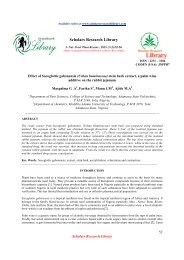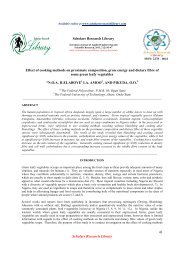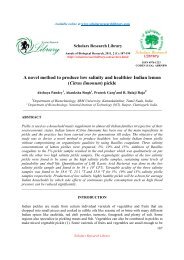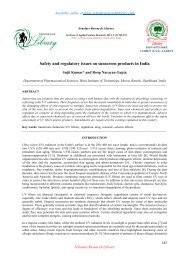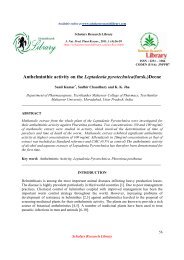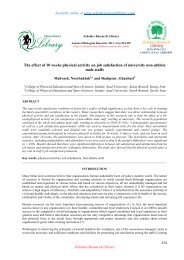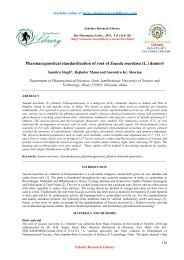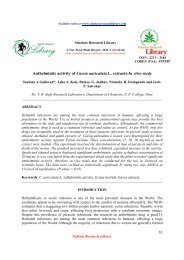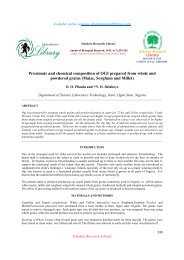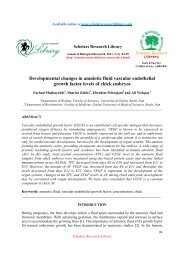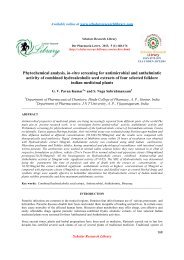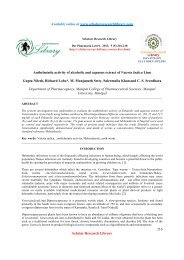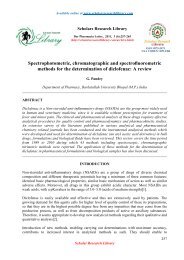The influence of MAP on sensory evaluation of chicken meal
The influence of MAP on sensory evaluation of chicken meal
The influence of MAP on sensory evaluation of chicken meal
You also want an ePaper? Increase the reach of your titles
YUMPU automatically turns print PDFs into web optimized ePapers that Google loves.
Available <strong>on</strong>line at www.scholarsresearchlibrary.com<br />
Scholars Research Library<br />
Annals <str<strong>on</strong>g>of</str<strong>on</strong>g> Biological Research, 2013, 4 (6):175-181<br />
(http://scholarsresearchlibrary.com/archive.html)<br />
ISSN 0976-1233<br />
CODEN (USA): ABRNBW<br />
<str<strong>on</strong>g>The</str<strong>on</strong>g> <str<strong>on</strong>g>influence</str<strong>on</strong>g> <str<strong>on</strong>g>of</str<strong>on</strong>g> <str<strong>on</strong>g>MAP</str<strong>on</strong>g> <strong>on</strong> <strong>sensory</strong> evaluati<strong>on</strong> <str<strong>on</strong>g>of</str<strong>on</strong>g> <strong>chicken</strong> <strong>meal</strong><br />
Nazanin Zand and Bahareh Sotoudeh<br />
Department <str<strong>on</strong>g>of</str<strong>on</strong>g> Food Industrial Engineering, Faculty <str<strong>on</strong>g>of</str<strong>on</strong>g> Agriculture, Islamic Azad University,<br />
Varamin-pishva branch, Varamin, Iran<br />
_____________________________________________________________________________________________<br />
ABSTRACT<br />
In this study ,<str<strong>on</strong>g>The</str<strong>on</strong>g> <str<strong>on</strong>g>influence</str<strong>on</strong>g> <str<strong>on</strong>g>of</str<strong>on</strong>g> different c<strong>on</strong>centrati<strong>on</strong>s <str<strong>on</strong>g>of</str<strong>on</strong>g> two gas mixture (Carb<strong>on</strong> dioxide, Nitrogen) : {(N 2 70% +<br />
CO 2 30%), (N 2 30% + CO 2 70%)}, and vacuum c<strong>on</strong>diti<strong>on</strong>s and also the effect <str<strong>on</strong>g>of</str<strong>on</strong>g> flexible multi-layer films has been<br />
studied for evaluati<strong>on</strong> <str<strong>on</strong>g>of</str<strong>on</strong>g> sec<strong>on</strong>d c<strong>on</strong>taminati<strong>on</strong> ,and <strong>sensory</strong> properties <str<strong>on</strong>g>of</str<strong>on</strong>g> <strong>chicken</strong> <strong>meal</strong> at refrigerator (T= 5 0 C).<br />
Chicken <strong>meal</strong>s(without spices) were packaged into <strong>on</strong>e kind <str<strong>on</strong>g>of</str<strong>on</strong>g> barrier pouch” 4 layers with thickness 136 µ (PET /<br />
AL / PET/LLD)” under modified atmosphere packaging (<str<strong>on</strong>g>MAP</str<strong>on</strong>g>) and vacuum c<strong>on</strong>diti<strong>on</strong>s and compared with<br />
ordinary c<strong>on</strong>diti<strong>on</strong>. Samples were performed microbial tests (Total count <str<strong>on</strong>g>of</str<strong>on</strong>g> bacteria, Clostridium botulinum count),<br />
and <strong>sensory</strong> evaluati<strong>on</strong> in different times. <str<strong>on</strong>g>The</str<strong>on</strong>g> modified atmosphere packaging weren’t lead to stop spoilage<br />
completely, but the spoilage process was delayed. <str<strong>on</strong>g>The</str<strong>on</strong>g> shelf life <str<strong>on</strong>g>of</str<strong>on</strong>g> <strong>chicken</strong> <strong>meal</strong>s under % 30 CO 2 and also<br />
vacuum c<strong>on</strong>diti<strong>on</strong>s in this c<strong>on</strong>tainer were 14 days ,but the best c<strong>on</strong>diti<strong>on</strong> bel<strong>on</strong>ged to samples under % 70 CO 2 ,<br />
which shelf life was extended to 21 days. <str<strong>on</strong>g>The</str<strong>on</strong>g> usage <str<strong>on</strong>g>of</str<strong>on</strong>g> this technique inactivated microorganism without a<br />
significant adverse effect <strong>on</strong> food properties. Other hand <strong>sensory</strong> evaluati<strong>on</strong> showed that increasing CO 2 increased<br />
retenti<strong>on</strong> time, and can adversely affect the taste <str<strong>on</strong>g>of</str<strong>on</strong>g> <strong>chicken</strong> <strong>meal</strong>. During the period <str<strong>on</strong>g>of</str<strong>on</strong>g> this experiment (3 to 21<br />
days) <strong>sensory</strong> properties (appearance, color, texture, odor, mouth feel) <str<strong>on</strong>g>of</str<strong>on</strong>g> samples in various c<strong>on</strong>diti<strong>on</strong>s, had no<br />
significant differences, .However taste <str<strong>on</strong>g>of</str<strong>on</strong>g> samples in treatment under % 70 CO 2 ,had significant differences with<br />
treatments under vacuum, % 30 CO 2 , other hand taste <str<strong>on</strong>g>of</str<strong>on</strong>g> samples during 7- 10 days, had significant differences in<br />
treatments under % 30 CO 2 , % 70 CO 2 ,and taste <str<strong>on</strong>g>of</str<strong>on</strong>g> samples after 14 days in treatment under % 70 CO 2 , had<br />
significant differences with treatments under vacuum , % 30 CO 2 . According to these results can be c<strong>on</strong>cluded the<br />
best c<strong>on</strong>diti<strong>on</strong> for evaluati<strong>on</strong> <strong>sensory</strong> properties bel<strong>on</strong>ged to treatment under modified atmosphere CO 2 70% too.<br />
Keywords: modified atmosphere packaging (<str<strong>on</strong>g>MAP</str<strong>on</strong>g>), <strong>sensory</strong> evaluati<strong>on</strong>, <strong>chicken</strong> <strong>meal</strong>, flexible multi-layer films<br />
_____________________________________________________________________________________________<br />
INTRODUCTION<br />
<str<strong>on</strong>g>The</str<strong>on</strong>g> c<strong>on</strong>sumpti<strong>on</strong> <str<strong>on</strong>g>of</str<strong>on</strong>g> poultry meat is growing up in development countries, in 1999 the world producti<strong>on</strong> <str<strong>on</strong>g>of</str<strong>on</strong>g> broiler<br />
<strong>chicken</strong>s reached 40 billi<strong>on</strong> and expects c<strong>on</strong>tinued growth until 2020 [2]. Poultry products specially <strong>chicken</strong> meat<br />
are universally popular, because they are not subject to cultural or religious restricti<strong>on</strong>s and this meat itself is<br />
perceived as healthy and nutritious as it c<strong>on</strong>tains relatively low fat c<strong>on</strong>tent and more desirable unsaturated fatty acids<br />
than other meats. <str<strong>on</strong>g>The</str<strong>on</strong>g> advantage <str<strong>on</strong>g>of</str<strong>on</strong>g> <strong>chicken</strong> meat is the fact that the quality <str<strong>on</strong>g>of</str<strong>on</strong>g> it is available for a wide range <str<strong>on</strong>g>of</str<strong>on</strong>g><br />
populati<strong>on</strong> and also in terms <str<strong>on</strong>g>of</str<strong>on</strong>g> acceptable prices. <str<strong>on</strong>g>The</str<strong>on</strong>g> shelf life extensi<strong>on</strong> <str<strong>on</strong>g>of</str<strong>on</strong>g> <strong>chicken</strong> meat and its products (sausage,<br />
ham, <strong>chicken</strong> <strong>meal</strong>, …..) are also important for the food industry in the qualitative compositi<strong>on</strong> which is <str<strong>on</strong>g>influence</str<strong>on</strong>g>d<br />
by various factors[17] . <str<strong>on</strong>g>The</str<strong>on</strong>g> modified atmosphere packaging (<str<strong>on</strong>g>MAP</str<strong>on</strong>g>) is well known that there is a n<strong>on</strong>-thermal<br />
method for inactivati<strong>on</strong> microorganism and is widely used for shelf-life prol<strong>on</strong>gati<strong>on</strong> and improvement the quality<br />
Scholars Research Library<br />
175
Nazanin Zand et al Annals <str<strong>on</strong>g>of</str<strong>on</strong>g> Biological Research, 2013, 4 (6):175-181<br />
_____________________________________________________________________________<br />
<str<strong>on</strong>g>of</str<strong>on</strong>g> perishable foods stored at refrigerati<strong>on</strong> temperatures [4,5,18]. Howere there is no degradati<strong>on</strong> <str<strong>on</strong>g>of</str<strong>on</strong>g> flavor and taste<br />
with heat denaturati<strong>on</strong> <str<strong>on</strong>g>of</str<strong>on</strong>g> objectives [11]. <str<strong>on</strong>g>The</str<strong>on</strong>g> ability <str<strong>on</strong>g>of</str<strong>on</strong>g> modified-atmosphere packaging for extending the shelf life<br />
<str<strong>on</strong>g>of</str<strong>on</strong>g> foods has been recognized for many years. Indeed, over 100 years ago [4,18]. Modified atmosphere packaging is<br />
the enclosure <str<strong>on</strong>g>of</str<strong>on</strong>g> a food, in a package in which the atmosphere has been changed by altering the proporti<strong>on</strong>s <str<strong>on</strong>g>of</str<strong>on</strong>g><br />
carb<strong>on</strong> dioxide, oxygen, nitrogen, water vapour and trace gases. <str<strong>on</strong>g>The</str<strong>on</strong>g> process limits microorganism as well as<br />
biochemical activity. This modificati<strong>on</strong> is performed by gas flash packaging which air is removed and replaced by a<br />
c<strong>on</strong>trolled mixture <str<strong>on</strong>g>of</str<strong>on</strong>g> gases [5]. <str<strong>on</strong>g>MAP</str<strong>on</strong>g> inhibits some microorganisms, so can increase the quality <str<strong>on</strong>g>of</str<strong>on</strong>g> variety foods.<br />
<str<strong>on</strong>g>The</str<strong>on</strong>g>se products (<strong>chicken</strong> <strong>meal</strong>) without a efficient processing are potential source <str<strong>on</strong>g>of</str<strong>on</strong>g> pathogens microorganism, since<br />
the low acidity (pH 4-5) and suitable water activity <str<strong>on</strong>g>of</str<strong>on</strong>g> these packed <strong>meal</strong>s, creates an ideal envir<strong>on</strong>ment for rapid<br />
microbial spoilage in this package [10, 11,20,21]. Although, thermal treatment (120 o C, 20 min) effectively destroys<br />
these microorganisms [11, 20,21], has been used widely, proteins and some other physiological substrates are<br />
inactivated, and c<strong>on</strong>sequently the <strong>sensory</strong> properties and c<strong>on</strong>tents <str<strong>on</strong>g>of</str<strong>on</strong>g> nutrients in foods are lost [20-25]. For that<br />
reas<strong>on</strong>, significant efforts are leading to the development <str<strong>on</strong>g>of</str<strong>on</strong>g> novel processing such as <str<strong>on</strong>g>MAP</str<strong>on</strong>g> [18, 20-25], which is<br />
proving to be able to inactivate spoilage microorganisms without significantly affect nutriti<strong>on</strong>al and <strong>sensory</strong><br />
properties <str<strong>on</strong>g>of</str<strong>on</strong>g> several foods [1]. However the growth <str<strong>on</strong>g>of</str<strong>on</strong>g> microorganisms depends <strong>on</strong> temperature, pH and water<br />
activity as the main growth-determining factors, other factors can significantly <str<strong>on</strong>g>influence</str<strong>on</strong>g> the growth characteristics<br />
<str<strong>on</strong>g>of</str<strong>on</strong>g> the microorganism. All menti<strong>on</strong>ed in this study include the initial CO 2/ N 2 c<strong>on</strong>centrati<strong>on</strong> (%) in the head space <str<strong>on</strong>g>of</str<strong>on</strong>g><br />
pouches as the independent variable for the gas atmosphere dem<strong>on</strong>strated that CO 2 exerts as an antimicrobial effect<br />
in the water-phase <str<strong>on</strong>g>of</str<strong>on</strong>g> the food product [4, 7, 18] , therefore except the effect <str<strong>on</strong>g>of</str<strong>on</strong>g> intrinsic, extrinsic and processing<br />
parameters <strong>on</strong> the CO 2 solubility, the c<strong>on</strong>centrati<strong>on</strong> <str<strong>on</strong>g>of</str<strong>on</strong>g> dissolved CO 2 in the water-phase <str<strong>on</strong>g>of</str<strong>on</strong>g> the food product should<br />
be incorporated in this study as independent variable [6]. Nitrogen (N2) is a n<strong>on</strong>-reactive gas that has no smell or<br />
taste, unlike carb<strong>on</strong> dioxide, is not absorbed in food or water [3]. It is used as a filler gas to replace oxygen and thus<br />
prevent spoilage or to replace carb<strong>on</strong> dioxide and prevent package collapse [4]. Sensory analysis is unequivocally<br />
assigning in the scientific methods. It is <strong>on</strong>e <str<strong>on</strong>g>of</str<strong>on</strong>g> the oldest means <str<strong>on</strong>g>of</str<strong>on</strong>g> quality c<strong>on</strong>trol, but in principle is an essential<br />
part <str<strong>on</strong>g>of</str<strong>on</strong>g> the mandatory assessment <str<strong>on</strong>g>of</str<strong>on</strong>g> food quality, while also examining the deeper study <str<strong>on</strong>g>of</str<strong>on</strong>g> the interdependence<br />
between physiological and psychological phenomena in the very process <str<strong>on</strong>g>of</str<strong>on</strong>g> percepti<strong>on</strong> <str<strong>on</strong>g>of</str<strong>on</strong>g> <strong>sensory</strong> qualities<br />
[12].Other hand the multi layers films have been used for packaging these <strong>meal</strong> are plastic films laminated with<br />
aluminum for packaging cooked meat and cooked poultry instead <str<strong>on</strong>g>of</str<strong>on</strong>g> can [3,20-25] .<str<strong>on</strong>g>The</str<strong>on</strong>g>se laminated packages with<br />
some metal comp<strong>on</strong>ent can c<strong>on</strong>siderably change the food temperatures and also microwave transparent with a high<br />
melting point [15,22]. <str<strong>on</strong>g>The</str<strong>on</strong>g> most comm<strong>on</strong> packages that have been tried, are individual pouches made <str<strong>on</strong>g>of</str<strong>on</strong>g> microwave<br />
transparent rigid films such as polyethylene (LLD) , and polyethylene terephtalate (PET) , which are barrier films<br />
[13, 14,20-25],and aluminum foil [15,22]. In this study. We investigate about the effects <str<strong>on</strong>g>of</str<strong>on</strong>g> modified atmosphere<br />
packaging; different c<strong>on</strong>centrati<strong>on</strong>s <str<strong>on</strong>g>of</str<strong>on</strong>g> CO2/N2 ; microbiological test [7], and the usage <str<strong>on</strong>g>of</str<strong>on</strong>g> <strong>on</strong>e multilayer flexible<br />
pouch and <str<strong>on</strong>g>MAP</str<strong>on</strong>g> [15,17,18,20] <strong>on</strong> <strong>sensory</strong> property <str<strong>on</strong>g>of</str<strong>on</strong>g> <strong>chicken</strong> <strong>meal</strong> during storage times. We want to prove <str<strong>on</strong>g>MAP</str<strong>on</strong>g><br />
can substitute thermal processing in c<strong>on</strong>servati<strong>on</strong> industries, and preserve <strong>sensory</strong> properties[18].<br />
MATERIALS AND METHODS<br />
2.1. Preparati<strong>on</strong> <str<strong>on</strong>g>of</str<strong>on</strong>g> <strong>chicken</strong> <strong>meal</strong><br />
Chickens (2 kg weight) were chosen for this experiment from local supermarket in Tehran -Iran. <str<strong>on</strong>g>The</str<strong>on</strong>g>se Chickens<br />
were washed and cooked under Pressure (1 bar) for 30 min with sauce (1.5% Salt, without spices) .Temperature was<br />
c<strong>on</strong>trolled in order to decrease to ambient temperature (T=25 ° C). After cooling , cooked <strong>chicken</strong> were cut into<br />
slices and samples were ready for packaging .Pouches c<strong>on</strong>tain 50 g , cooked <strong>chicken</strong> without spices (20,21,23-25) .<br />
Analytical parameters such as pH (Cris<strong>on</strong> 2001 pH meter; Cris<strong>on</strong> Instruments, SA, Barcel<strong>on</strong>a, Spain) soluble solid<br />
c<strong>on</strong>tent (Atago RX-1000 refract meter; Atago Company Ltd., Japan), were measured according to the ISIRI<br />
regulati<strong>on</strong> [20-25].<br />
2.2. Modified Atmosphere Packaging<br />
Henkelman packing machine, model Boxer-200A was used in this project. Samples were packed into <strong>on</strong>e multilayer<br />
flexible pouch (4 layers) (PET/AL/PET/LLD) under modified atmosphere [13,14,19]. After packaging, samples<br />
were put in refrigerator immediately, for evaluati<strong>on</strong> sec<strong>on</strong>d c<strong>on</strong>taminati<strong>on</strong> and <strong>sensory</strong> properties.<br />
Scholars Research Library<br />
176
Nazanin Zand et al Annals <str<strong>on</strong>g>of</str<strong>on</strong>g> Biological Research, 2013, 4 (6):175-181<br />
_____________________________________________________________________________<br />
A B C<br />
Fig 1.(A) Modified atmosphere packaging, (B) gas analyzer, (C) gas flash tank(Model: Boxer-200A)<br />
2.3. Microbial culture<br />
PCA(Pept<strong>on</strong>e from casein 5g/1000 ml; glucose 1g/1000 ml, Yeast Extract 2.5 g/1000 ml, Agar 14g/1000 ml,<br />
Distillated water 1000 ml),plate count agar is a general media for aerobic, RCA (Pept<strong>on</strong>e from casein 10g/1000 ml;<br />
Meat Extract 10g/1000, Yeast Extract 3g/1000 ml, Starch 1g/1000 ml, glucose 5 g/1000 ml,l- cystein hydrochloride<br />
0.5g/1000 ml, Sodium acetate 3g/1000 ml, Sodium chloride 5 g/1000 ml, Agar12.5g/1000 ml, Distillated water 1000<br />
ml)Rein Clostridia is a culture Media for clostridium.CMM(Beef heart 454g/1000 ,Proteose pept<strong>on</strong>e 20 g/1000 ml,<br />
glucose 5 g/1000 ml, Sodium chloride 5g/1000 ml, Sodium hydrochloride ½ 454 g/1000, Distillated water 1000<br />
ml).Cooked Meat is an enrichment media for aerobic bacteria.PE 2(Pept<strong>on</strong>e digest <str<strong>on</strong>g>of</str<strong>on</strong>g> animal extract 20 g/1000 ml,<br />
Yeast Extract 3g/1000 ml ,2%Alcoholic soluti<strong>on</strong> <str<strong>on</strong>g>of</str<strong>on</strong>g> bromocresol purple 0.04g/1000 ml,Cicer arietinum L450 no,<br />
Distillated water1000 ml) Pept<strong>on</strong>e Yeast Extract Bromocresol Purple is an enrichment media for anaerobic bacteria<br />
[8, 9,19,20,21, 23-25].<br />
Total count <str<strong>on</strong>g>of</str<strong>on</strong>g> microorganisms in PCA culture, and Clostridium botulinum count in the RCA culture<br />
1 g <str<strong>on</strong>g>of</str<strong>on</strong>g> sample was weighed under the microbial laboratory hood, and was crushed in 10 ml <str<strong>on</strong>g>of</str<strong>on</strong>g> ringer's soluti<strong>on</strong>.<br />
According to CFU method, divided into <strong>on</strong>e series tube (six tubes) which c<strong>on</strong>tain 9 cc sterile distilled water . First<br />
1 cc <str<strong>on</strong>g>of</str<strong>on</strong>g> the sample added to tube no <strong>on</strong>e and transferred tube by tube, while main sample was prepared by serial<br />
diluti<strong>on</strong>(0.01,0.001…). Finally pour plate method were d<strong>on</strong>e in the PCA culture and RCA culture ,too in order to<br />
count (A) total number <str<strong>on</strong>g>of</str<strong>on</strong>g> microorganisms which was incubated in 37 ° C for 3 days , and (B) Clostridium<br />
botulinum which was incubated for 4 days at 37 ° C [8].<br />
2. 4-Samples packaging and storage<br />
All pouches (unprocessed and processed <strong>chicken</strong> <strong>meal</strong>s), were put at refrigerator temperature (T= 5° C).Samples<br />
were packaged into <strong>on</strong>e multilayer flexible films (4 layers) .Analytical characteristics <str<strong>on</strong>g>of</str<strong>on</strong>g> this barrier c<strong>on</strong>tainer was<br />
shown in table 1 [15,16,22].<br />
Table 1- Analytical characteristics <str<strong>on</strong>g>of</str<strong>on</strong>g> c<strong>on</strong>tainer [15, 16, 22]<br />
Sample<br />
Layers<br />
Thickness<br />
(µ)<br />
Tensile <str<strong>on</strong>g>of</str<strong>on</strong>g> film<br />
(N)<br />
Tensile <str<strong>on</strong>g>of</str<strong>on</strong>g> sealing film<br />
(N)<br />
O.T.R<br />
(ml/m 2 .day)<br />
W.V.T.R<br />
(gr/m 2 .day)<br />
PET\AL\PET\LLD 12\7\12\100 136 104.61 61.03 0 0.089<br />
PET: Poly Ethylene Terphetalat; LLD: Low Density Poly Ethylene ; AL: Aluminum<br />
3. Statistical Analysis<br />
In order to describe the variables <str<strong>on</strong>g>of</str<strong>on</strong>g> this experiment, we must design a model to analysis relati<strong>on</strong>ship between type<br />
<str<strong>on</strong>g>of</str<strong>on</strong>g> <strong>meal</strong>, type <str<strong>on</strong>g>of</str<strong>on</strong>g> treatments, and <strong>sensory</strong> properties. So comparis<strong>on</strong> <str<strong>on</strong>g>of</str<strong>on</strong>g> data, which was performed by the prism test.<br />
RESULTS<br />
Total count <str<strong>on</strong>g>of</str<strong>on</strong>g> microorganisms and Clostridium botulinum count<br />
According to total count <str<strong>on</strong>g>of</str<strong>on</strong>g> microorganisms in PCA media, the growth <str<strong>on</strong>g>of</str<strong>on</strong>g> these bacteria’s in c<strong>on</strong>trol sample were<br />
observed after 3 days. Although growth <str<strong>on</strong>g>of</str<strong>on</strong>g> bacteria were observed in C1, C2, after 14 days and in C3 after 21 days.<br />
As you see in table 2 .<str<strong>on</strong>g>The</str<strong>on</strong>g> most growth <str<strong>on</strong>g>of</str<strong>on</strong>g> bacteria’s bel<strong>on</strong>g to vacuum c<strong>on</strong>diti<strong>on</strong>, then in 30%CO2 and 70% CO2.<br />
Other hand Clostridium botulinum count in RCM media was shown, the growth <str<strong>on</strong>g>of</str<strong>on</strong>g> Clostridium , in c<strong>on</strong>trol sample<br />
was observed after 3 days, but in vacuum c<strong>on</strong>diti<strong>on</strong> and gas compositi<strong>on</strong> (% 30 CO2 +% 70 N2) was observed after<br />
14 days, and there was significant difference between treatments C1 and C2 .<str<strong>on</strong>g>The</str<strong>on</strong>g> reas<strong>on</strong> can be described by<br />
Scholars Research Library<br />
177
Nazanin Zand et al Annals <str<strong>on</strong>g>of</str<strong>on</strong>g> Biological Research, 2013, 4 (6):175-181<br />
_____________________________________________________________________________<br />
relati<strong>on</strong> between the type <str<strong>on</strong>g>of</str<strong>on</strong>g> modified atmosphere in package. <str<strong>on</strong>g>The</str<strong>on</strong>g> number <str<strong>on</strong>g>of</str<strong>on</strong>g> Clostridium botulinum was observed<br />
in vacuum c<strong>on</strong>diti<strong>on</strong>, was more than other <str<strong>on</strong>g>MAP</str<strong>on</strong>g> c<strong>on</strong>diti<strong>on</strong>s. <str<strong>on</strong>g>The</str<strong>on</strong>g> growth <str<strong>on</strong>g>of</str<strong>on</strong>g> Clostridium botulinum in a gas<br />
compositi<strong>on</strong> (70% CO 2 + 30% N 2 ) was observed after 21 days, as you see in table 3. <str<strong>on</strong>g>The</str<strong>on</strong>g> variables were shown by<br />
different letter in each column had not significantly level with others. (P
Nazanin Zand et al Annals <str<strong>on</strong>g>of</str<strong>on</strong>g> Biological Research, 2013, 4 (6):175-181<br />
_____________________________________________________________________________<br />
Fig 2- <str<strong>on</strong>g>The</str<strong>on</strong>g> appearance <str<strong>on</strong>g>of</str<strong>on</strong>g> samples during storage times (3 to 21 days), under various c<strong>on</strong>centrati<strong>on</strong> <str<strong>on</strong>g>of</str<strong>on</strong>g> co 2<br />
4-2-Color: During the period <str<strong>on</strong>g>of</str<strong>on</strong>g> this experiment ( 3 to 21 days) ;color <str<strong>on</strong>g>of</str<strong>on</strong>g> samples in various c<strong>on</strong>diti<strong>on</strong>s, had no<br />
significant differences.<br />
Fig 3- <str<strong>on</strong>g>The</str<strong>on</strong>g> Color <str<strong>on</strong>g>of</str<strong>on</strong>g> samples during storage times (3 to 21 days), under various c<strong>on</strong>centrati<strong>on</strong> <str<strong>on</strong>g>of</str<strong>on</strong>g> co 2<br />
4-3-Texture: During the period <str<strong>on</strong>g>of</str<strong>on</strong>g> this experiment (3 to 21 days) ;texture <str<strong>on</strong>g>of</str<strong>on</strong>g> samples in various c<strong>on</strong>diti<strong>on</strong>s, had no<br />
significant differences.<br />
Fig 4- <str<strong>on</strong>g>The</str<strong>on</strong>g> texture <str<strong>on</strong>g>of</str<strong>on</strong>g> samples during storage times (3 to 21 days), under various c<strong>on</strong>centrati<strong>on</strong> <str<strong>on</strong>g>of</str<strong>on</strong>g> co 2<br />
4-4-Taste :During the period <str<strong>on</strong>g>of</str<strong>on</strong>g> this experiment ( 3 to 21 days) ;taste <str<strong>on</strong>g>of</str<strong>on</strong>g> <strong>meal</strong>s in treatment C after 3 days, had<br />
significant differences in comparis<strong>on</strong> with treatment A .(P
Nazanin Zand et al Annals <str<strong>on</strong>g>of</str<strong>on</strong>g> Biological Research, 2013, 4 (6):175-181<br />
_____________________________________________________________________________<br />
Fig 5- <str<strong>on</strong>g>The</str<strong>on</strong>g> taste <str<strong>on</strong>g>of</str<strong>on</strong>g> samples during storage times (3 to 21 days), under various c<strong>on</strong>centrati<strong>on</strong> <str<strong>on</strong>g>of</str<strong>on</strong>g> co 2<br />
4-5-Odor: During the period <str<strong>on</strong>g>of</str<strong>on</strong>g> this experiment (3 to 21 days); odor <str<strong>on</strong>g>of</str<strong>on</strong>g> samples in various c<strong>on</strong>diti<strong>on</strong>s, had no<br />
significant differences.<br />
Fig 6- <str<strong>on</strong>g>The</str<strong>on</strong>g> odor <str<strong>on</strong>g>of</str<strong>on</strong>g> samples during storage times (3 to 21 days), under various c<strong>on</strong>centrati<strong>on</strong> <str<strong>on</strong>g>of</str<strong>on</strong>g> co 2<br />
4-6- Mouth feel: During the period <str<strong>on</strong>g>of</str<strong>on</strong>g> this experiment ( 3 to 21 days) ; mouth feel <str<strong>on</strong>g>of</str<strong>on</strong>g> samples in various c<strong>on</strong>diti<strong>on</strong>s<br />
,had no significant differences.<br />
Fig 7- <str<strong>on</strong>g>The</str<strong>on</strong>g> m<strong>on</strong>th feels <str<strong>on</strong>g>of</str<strong>on</strong>g> samples during storage times (3 to 21 days), under various c<strong>on</strong>centrati<strong>on</strong> <str<strong>on</strong>g>of</str<strong>on</strong>g> co 2<br />
CONCLUSION<br />
1- <str<strong>on</strong>g>The</str<strong>on</strong>g> shelf life <str<strong>on</strong>g>of</str<strong>on</strong>g> <strong>chicken</strong> <strong>meal</strong> which were packaged under vacuum, , and also ( % 30 CO 2 +% 70 N 2 ) c<strong>on</strong>diti<strong>on</strong><br />
in 4 layers flexible pouch (136 µ) were 14 days . <str<strong>on</strong>g>The</str<strong>on</strong>g> best c<strong>on</strong>diti<strong>on</strong> bel<strong>on</strong>ged to ( N 2 30% + CO 2 70% ) which shelf<br />
life was 21 days. <str<strong>on</strong>g>The</str<strong>on</strong>g> best shelf life <str<strong>on</strong>g>of</str<strong>on</strong>g> <strong>chicken</strong> <strong>meal</strong> in ordinary c<strong>on</strong>diti<strong>on</strong>s at refrigerator (T=5 o C) is 3 to 5 days.<br />
According to these results sec<strong>on</strong>d c<strong>on</strong>taminati<strong>on</strong> were c<strong>on</strong>trolled and shelf life can be extended to 21 days.<br />
2- <str<strong>on</strong>g>The</str<strong>on</strong>g> modified atmosphere packaging (<str<strong>on</strong>g>MAP</str<strong>on</strong>g>) weren’t lead to stop spoilage completely .<str<strong>on</strong>g>The</str<strong>on</strong>g> effect <str<strong>on</strong>g>of</str<strong>on</strong>g> <str<strong>on</strong>g>MAP</str<strong>on</strong>g> was not<br />
adequate, using this technique inactivated microorganism without a significant adverse effect <strong>on</strong> food properties.<br />
Other hand <strong>sensory</strong> properties showed that increasing CO 2 increased retenti<strong>on</strong> time, and can adversely affect the<br />
taste <str<strong>on</strong>g>of</str<strong>on</strong>g> <strong>chicken</strong> <strong>meal</strong> under modified atmosphere. During the period <str<strong>on</strong>g>of</str<strong>on</strong>g> this experiment ( 3-21days) <strong>sensory</strong><br />
properties (appearance, color, texture, odor, mouth feel) <str<strong>on</strong>g>of</str<strong>on</strong>g> samples in various c<strong>on</strong>diti<strong>on</strong>s, had no significant<br />
differences, ,however taste <str<strong>on</strong>g>of</str<strong>on</strong>g> samples in treatment C ,had significant differences with treatments A ,B, other hand<br />
taste <str<strong>on</strong>g>of</str<strong>on</strong>g> samples during 7- 10 days, had significant differences with treatments C ,B, and taste <str<strong>on</strong>g>of</str<strong>on</strong>g> samples after 14<br />
Scholars Research Library<br />
180
Nazanin Zand et al Annals <str<strong>on</strong>g>of</str<strong>on</strong>g> Biological Research, 2013, 4 (6):175-181<br />
_____________________________________________________________________________<br />
days in treatment C, had significant differences with treatments A ,B. According to these results can be c<strong>on</strong>cluded<br />
the best c<strong>on</strong>diti<strong>on</strong> for <strong>sensory</strong> properties bel<strong>on</strong>ged to ( N 2 30% + CO 2 70% ) too.<br />
Acknowledgements<br />
<str<strong>on</strong>g>The</str<strong>on</strong>g> authors appreciate , Dr Maryam Tajabadi Ebrahimi ( Department <str<strong>on</strong>g>of</str<strong>on</strong>g> Biology, Islamic Azad University , Tehran<br />
Central Branch, Tehran, Iran ),Eng. Mahsa Dameshghiyan, Eng. Bahram Ghobadiyan and PMA Com (Plastic<br />
Machine Alvan, Tehran-Iran) for supplying equipments and materials<br />
REFRENCES<br />
[1] Bingol EB. , Ergun O., 2011,Meat science, 88(4):774-85.<br />
[2] Bilgili S. F.2002. Poultry Internati<strong>on</strong>al, p. 12-22.<br />
[3] Coma V. , 2008, Meat science, 78(1):90-103.<br />
[4] Church, N., 1994,Trends in food science & technology, 5(11):345-352.<br />
[5] Desrosier NW, Desrosier JN. ,1977, <str<strong>on</strong>g>The</str<strong>on</strong>g> technology <str<strong>on</strong>g>of</str<strong>on</strong>g> food preservati<strong>on</strong>: AVI Publishing Company, Inc.<br />
[6] Devlieghere F, Van Belle B, Debevere J., 1999 , Internati<strong>on</strong>al journal <str<strong>on</strong>g>of</str<strong>on</strong>g> food microbiology,46(1):57-70.<br />
[7] Esmer OK, Irkin R, Degirmencioglu N, Degirmencioglu A. ,2011, Meat science,88(2):221-6<br />
[8] Institute Of Standards And Industrial Research Of Iran (ISIRI), 2003,No 2326, Canned food- Specificati<strong>on</strong> and<br />
test methods , 1 nd .Revisi<strong>on</strong>, Karaj – Iran<br />
[9] Institute Of Standards And Industrial Research Of Iran (ISIRI), 2003,No 3139, Low acid canned food –Causes <str<strong>on</strong>g>of</str<strong>on</strong>g><br />
microbil spoilage,1 nd .Revisi<strong>on</strong>, Karaj – Iran<br />
[10] Jay, J.M., Vilai, J.P., Hughes, M.E., 2003, Pr<str<strong>on</strong>g>of</str<strong>on</strong>g>ile and activity <str<strong>on</strong>g>of</str<strong>on</strong>g> the bacterial biota <str<strong>on</strong>g>of</str<strong>on</strong>g> ground beef held from<br />
freshness to spoilage at 5–7 1C., Int. J. Food Microbial,81, 105–1113, 587–60<br />
[11] Mortazavi A, Kasshani N, Ziaolhagh H., 2002,Food Microbiology (WC Frazier), Ferdowsi University Press<br />
[12] Neumann, R., Arnold S. 1990. Senzorické skúmanie potravín. In Alfa-Bratislava, 352 p, ISBN 80-05-006 12-8.<br />
[13] O'Meara, J. P., Farkas, D. F. and Wadsworth, C. K., 1977, Flexible pouch sterilizati<strong>on</strong> using a combined<br />
microwave-hot water hold simulator. Natick, MA. US Army, Natick Research & Development Lab, Unpublished<br />
Report. (PN) DRYNM P:77-120<br />
[14] Ohlss<strong>on</strong>, T. ,1991, Development and evaluati<strong>on</strong> <str<strong>on</strong>g>of</str<strong>on</strong>g> a microwave sterilizati<strong>on</strong> process for plastic pouches. 8th<br />
World C<strong>on</strong>gress <str<strong>on</strong>g>of</str<strong>on</strong>g> Food Science and Technology. Tor<strong>on</strong>to, CA. Sept. 29- Oct. 4<br />
[15] Paine FA., Paine HY., 1992, A handbook <str<strong>on</strong>g>of</str<strong>on</strong>g> food packaging: Springer<br />
[16] Plastic mashine alvan(P.M.A) com,2006, Tehran ,Iran (www,printopackcom)<br />
[17] Van Horne, P. L. M., 2002, In Archiv fur Geflugelkunde, vol. 66, p. 26-27.<br />
[18] Young H., 1987,Food Microbiology,4(5):317-327.<br />
[19] Young H, Young A, Light N. ,1987,Food Microbiology,4(4):317-327.<br />
[20] Zand N., Foroudi F., Mailova E. and V.Voskanyan A., 2010, African Journal <str<strong>on</strong>g>of</str<strong>on</strong>g> Microbiology Research. 4, 19,<br />
2011-2021<br />
[21] Zand N., Foroudi F., Mailova E. and V.Voskanyan A., 2010, African Journal <str<strong>on</strong>g>of</str<strong>on</strong>g> Microbiology Research. 4, 23,<br />
2010. 2468-2478<br />
[22] Zand N. ,2011, Annals <str<strong>on</strong>g>of</str<strong>on</strong>g> Biological Research, vol. 2, issue 2 , P: 488-501<br />
[23] Zand N. ,2011, Annals <str<strong>on</strong>g>of</str<strong>on</strong>g> Biological Research, vol. 2, issue 3 , P: 442-452<br />
[24] Zand N. ,2011, Annals <str<strong>on</strong>g>of</str<strong>on</strong>g> Biological Research, vol. 2, issue 4, , P: 398-407<br />
[25] Zand N. ,2013, European Journal <str<strong>on</strong>g>of</str<strong>on</strong>g> Experimental Biology, vol. 3, issue 2, P:598-607<br />
Scholars Research Library<br />
181



